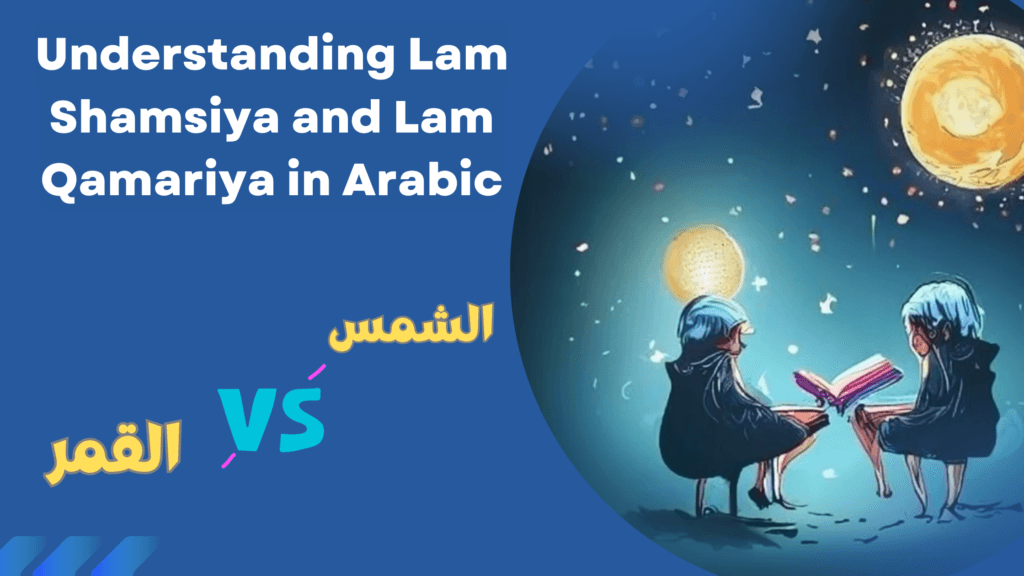If you are a beginner in learning Arabic, it is essential to know the difference between Lam Shamsiya and Lam Qamariya. These two forms of the Arabic letter “ل” (laam) significantly impact pronunciation and are fundamental to mastering the language. In this article, we will explore Lam Shamsiya and Lam Qamariya with examples to help you understand their usage.
What is the Laam Qamariya?
Lam Qamariya (ل) is written and pronounced clearly. It is connected to a vowel and does not have a shaddah (a diacritical mark that indicates a double consonant). The name “Qamariya” is derived from the Arabic word “قمر” (qamar), meaning “moon,” as this type of “ل” is pronounced similarly to the soft light of the moon.
Examples of Lam Qamariya:
- القمر (al-qamar) – The moon
- الكتاب (al-kitab) – The book
- الجبل (al-jabal) – The mountain
- البحر (al-bahr) – The sea
In these examples, the “ل” in “ال” is pronounced, followed by the letter that comes after it.
What is Lam Shamsiya?
Lam Shamsiya (ل) is also written but not pronounced. Instead, the letter following “ل” is pronounced with a shaddah. The name “Shamsiya” comes from the Arabic word “شمس” (shams), meaning “sun,” as the pronunciation is intense and strong, much like the sun’s rays.
Examples of Lam Shamsiya:
- الشمس (ash-shams) – The sun
- السماء (as-sama) – The sky
- الطبيب (at-tabeeb) – The doctor
- النجاح (an-najah) – The success
In these examples, the “ل” in “ال” is not pronounced, and the letter following it is doubled in pronunciation due to the shaddah.
How to Identify Lam Shamsiya and Lam Qamariya
Identifying whether a word uses Lam Shamsiya or Lam Qamariya is straightforward once you know the consonants involved. Here’s a quick guide:
- Lam Qamariya is followed by these letters: أ (alif), ب (baa), ج (jeem), ح (haa), خ (khaa), ع (ain), غ (ghain), ف (faa), ق (qaaf), ك (kaaf), م (meem), ه (haa), و (waaw), ي (yaa).
- Lam Shamsiya is followed by these letters: ت (taa), ث (thaa), د (daal), ذ (dhaal), ر (raa), ز (zaay), س (seen), ش (sheen), ص (saad), ض (daad), ط (taa), ظ (thaa), ل (laam), ن (noon).
Listen and Repeat: Master the Pronunciation of اللام الشمسية and اللام القمرية
Now that you understand the basic rules of lam shamsiya and lam qamariya, it’s time to hear how they sound in real Arabic!
Below, you’ll find an interactive audio section — simply click the speaker icons to listen to each example pronounced by a native Arabic speaker. Then, repeat each word out loud to practice the correct lam shamsiya pronunciation and lam qamariya pronunciation.
Learning pronunciation through listening and repetition helps you train your ear, improve fluency, and build confidence when reading Arabic aloud. Use this tool as often as you like — the more you repeat, the faster you’ll sound like a native!
Examples of اللام الشمسية (Lam Shamsiya) — Sun Letters Arabic
When a sun letter (حرف شمسي) follows the lam in ال, you do not pronounce the lam and you double the following letter.
Listen carefully and repeat these lam shamsiya examples:
الشَّمس – ash-shams (the sun)
النَّاس – an-nās (the people)
الطَّريق – at-tarīq (the road)
السَّماء – as-samā’ (the sky)
الزَّيتون – az-zaytūn (the olive)
👉 Tip: Notice how the lam disappears and the next letter sounds doubled. Try to imitate that doubling sound.
Examples of اللام القمرية (Lam Qamariya) — Moon Letters Arabic
When a moon letter (حرف قمري) follows the lam in ال, you pronounce the lam clearly.
Listen and repeat these lam qamariya examples:
القمر – al-qamar (the moon)
البيت – al-bayt (the house)
الكِتاب – al-kitāb (the book)
الولد – al-walad (the boy)
الملعب– al-malʿab (the stadium)
👉 Tip: Pay attention to the clear “al” sound at the beginning — that’s what makes it lam qamariya.
Try It Yourself!
After listening to each example:
- Repeat the word three times.
- Focus on whether you can hear and feel the difference between lam shamsiya and lam qamariya.
- Record yourself and compare your pronunciation to the audio — this is one of the best lam shamsiya exercises you can do!
With continuous listening and repetition, you’ll master the rhythm of اللام الشمسية والقمرية and read Arabic words with confidence and precision.
Practical Tips for Learning Lam Shamsiya and Lam Qamariya
1. Practice with Real Examples
Start by collecting lam shamsiya examples and lam qamariya examples from your Arabic books or online lessons.
For example:
- الشمس (ash-shams) – sun (uses lam shamsiya)
- القمر (al-qamar) – moon (uses lam qamariya)
Notice how the lam sound in اللام الشمسية disappears when followed by a sun letter, while it is clearly pronounced in اللام القمرية. Practicing these differences daily will help you easily identify lam shamsiya lam qamariya words in texts.
2. Focus on Pronunciation
Learning how to pronounce lam shamsiya correctly is crucial.
In اللام الشمسية, the lam is silent and merges with the following letter, while in اللام القمرية, it is fully pronounced.
Listen carefully to how native speakers pronounce sun letters Arabic and moon letters Arabic, and repeat after them.
Mastering lam shamsiya pronunciation will make your reading smoother and your Arabic sound more authentic.
3. Listen and Repeat
Use Arabic learning apps, YouTube channels, or podcasts to train your ear. Choose lessons that clearly distinguish laam shamsiyya and laam qamariyya sounds.
Listening to native pronunciation will help you internalize lam qamariya rules and improve your fluency.
Try to repeat each word several times until the difference feels natural.
4. Use Flashcards and Worksheets
Create flashcards with two categories — one for حروف شمسية (sun letters) and one for حروف قمرية (moon letters).
Write example words under each group and review them daily. You can also download a printable lam qamariya worksheet or interactive lam shamsiya exercises to test your knowledge.
If you have a teaching blog, link to a resource such as:
👉 Download Lam Shamsiya and Lam Qamariya Worksheet (PDF)
5. Immerse Yourself in Native Arabic Content
Watch Arabic TV shows, listen to Arabic songs, and read children’s stories or short articles. Immersing yourself in authentic material helps you notice lam shamsiya and lam qamariya usage naturally.
Over time, you’ll start recognizing اللام الشمسية و القمرية without even thinking about the rules — just like native speakers do.
6. Practice with Native Speakers
Ask a native speaker or Arabic teacher to listen to your pronunciation.
Reading aloud together will help you correct any mistakes with lam shamsiya pronunciation or lam qamariya pronunciation.
This real-time feedback is one of the fastest ways to improve your accuracy.
7. Ask for Help and Keep Practicing
Still unsure whether a word contains lam shamsiya or lam qamariya? Leave a comment below, and we’ll help you identify the correct form!
Remember: learning اللام الشمسية والقمرية takes patience, but regular practice will make you more confident and fluent.
Final Tip
Mastering lam shamsiya lam qamariya is not just about memorizing letters — it’s about listening, repeating, and immersing yourself in the Arabic sound system. With daily practice using lam shamsiya exercises, lam qamariya examples, and authentic Arabic content, you’ll soon pronounce every word naturally and accurately.











